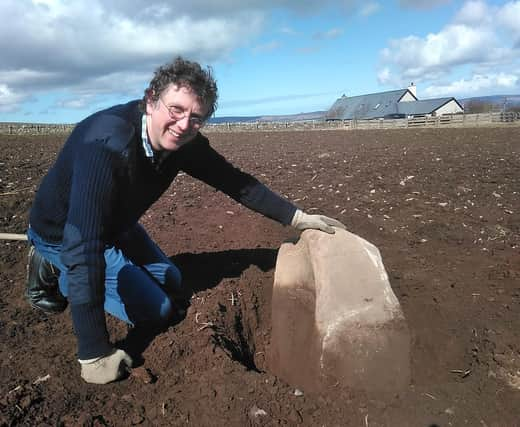Ancient settlement 'older than Skara Brae' emerges on Orkney


A huge prehistoric quernstone was struck upon by farmers ploughing fields near Saverock, St Ola, earlier this month.
The saddle quern, which was used for grinding grain concealed a layer of sherds of Early Neolithic pottery.
Advertisement
Hide AdAdvertisement
Hide AdEarlier finds, including an arrow head and further pieces of broken vessel have suggested an Early Neolithic date (c3600-3200BC) for the Saverock settlement, meaning it pre-dates Skara Brae, Orkney’s best-known New Stone Age settlement by centuries.
Skara Brae was first occupied around 3,100 BC, it is believed.
Chris Gee, a project officers at University of the Highlands and Islands Archaeology Institute, has been investigating the area since 2014.
He said he believed two early Neolithic houses may have stood at Saverock.
He said: “Finding the saddle quern was just remarkable. I find it amazing that something like that can be found just below the plough line.
"A saddle quern would have been one of the most important tools in the house, after the fire.”
He said he believed there were many more early Neolithic sites in Orkney.
"The more sites you find, the more you understand – and the more questions are raised.”
Advertisement
Hide AdAdvertisement
Hide AdThe quern, which is 87cm long and 60cm wide, is estimated to weigh over 200 kg and gives further insight into early life at Saverock.
It is hoped that charcoal found under the stone can be radiocarbon dated, allowing archaeologists to see where the Saverock site fits in with the three other known Early Neolithic settlements clustered around the lower slopes of Wideford Hill.
Mr Gee thanked John Hamilton and Derek Shearer for their assistance in recovering the quern and the landowner, William Harcus, for allowing access.
Archaeologists on Orkney continue to illuminate the Neolithic landscape of the islands in a series of remarkable finds.
In February, they discovered what is believed to be ‘another Skara Brae’ after evidence of a similar settlement was found around half a mile away from the world-famous site at the north end of the Bay of Skaill.
Deer antlers, a boar tooth, a cattle jawbone and a large decorated stone were also found with it thought the discoveries were between 4,000 and 5,000 years old.
The new finds have refreshed interest in who may have lived around the bay during the New Stone Age.
Last week, the people were placed firmly back into the Neolithic landscape when a potter’s fingerprint was discovered on a piece of broken vessel that is thought to have been around 5,000-years-old.
Advertisement
Hide AdAdvertisement
Hide AdThe discovery was made at the vast Ness of Brodgar site, a complex of monumental buildings that forms part of the Heart of Neolithic Orkney World Heritage Site.
It is believed the potter left the print as he worked with wet clay.
Nick Card, excavation director of the long-running Ness of Brodgar excavation said, the discovery “brought the people back into focus” at the site.
He said: “Although finding the fingerprint impression won’t hugely impact our work, it does give us a highlypersonal, poignant connection to the people of Neolithic Orkney, 5,000 years ago.”
